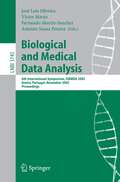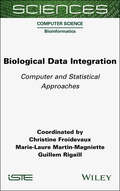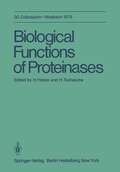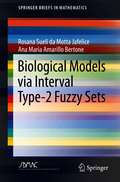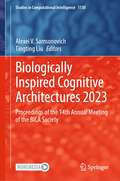- Table View
- List View
Biological and Medical Data Analysis: 7th International Symposium, ISBMDA 2006, Thessaloniki, Greece, December 7-8, 2006. Proceedings (Lecture Notes in Computer Science #4345)
by Nicos Maglaveras Ioanna Chouvarda Vassilis Koutkias Rüdiger BrauseThis book constitutes the refereed proceedings of the 7th International Symposium on Biological and Medical Data Analysis, ISBMDA 2006, held in Thessaloniki, Greece, December 2006. Coverage in this volume includes functional genomics, sequence analysis, biomedical models, information modeling, biomedical signal processing, biomedical image analysis, biomedical data analysis, as well as decision support systems and diagnostic tools.
Biological and Medical Data Analysis: 5th International Symposium, ISBMDA 2004, Barcelona, Spain, November 18-19, 2004, Proceedings (Lecture Notes in Computer Science #3337)
by Víctor Maojo Ferran Sanz José María Barreiro Fernando Martin-SanchezBiological and Medical Data Analysis: 6th International Symposium, ISBMDA 2005, Aveiro, Portugal, November 10-11, 2005, Proceedings (Lecture Notes in Computer Science #3745)
by José Luis Oliveira Víctor Maojo Fernando Martin-Sanchez António Sousa PereiraBiological Antenna to the Humanoid Bot: Electromagnetic Resonances in Biomaterials (Studies in Rhythm Engineering)
by Kanad Ray Anirban Bandyopadhyay Pushpendra SinghThe book outlines a pathway to the development of fusion of electromagnetic resonance and artificial intelligence which will dominate the world of communication engineering. Electromagnetic resonance is fundamental to all biomaterials. The authors explore the peculiarities of this typical resonance behaviour in the literatures and provide the key points where the research should direct. Biological antennas are inspiring designing of several electromagnetic devices. From biomimetic engineering to humanoid bots a revolution is undergoing. Authors include entire development in the form of a book along with their contribution to this field.
Biological Data Integration: Computer and Statistical Approaches
by Christine Froidevaux Marie-Laure Martin-Magniette Guillem RigaillThe study of biological data is constantly undergoing profound changes. Firstly, the volume of data available has increased considerably due to new high throughput techniques used for experiments. Secondly, the remarkable progress in both computational and statistical analysis methods and infrastructures has made it possible to process these voluminous data. The resulting challenge concerns our ability to integrate these data, i.e. to use their complementary nature effectively in the hope of advancing our knowledge. Therefore, a major challenge in studying biology today is integrating data for the most exhaustive analysis possible. Biological Data Integration deals in a pedagogical way with research work in biological data science, examining both computational approaches to data integration and statistical approaches to the integration of omics data
Biological Data Integration: Computer and Statistical Approaches
by Christine Froidevaux Guillem Rigail Marie-Laure Martin MagnietteThe study of biological data is constantly undergoing profound changes. Firstly, the volume of data available has increased considerably due to new high throughput techniques used for experiments. Secondly, the remarkable progress in both computational and statistical analysis methods and infrastructures has made it possible to process these voluminous data. The resulting challenge concerns our ability to integrate these data, i.e. to use their complementary nature effectively in the hope of advancing our knowledge. Therefore, a major challenge in studying biology today is integrating data for the most exhaustive analysis possible. Biological Data Integration deals in a pedagogical way with research work in biological data science, examining both computational approaches to data integration and statistical approaches to the integration of omics data
Biological Functions for Information and Communication Technologies: Theory and Inspiration (Studies in Computational Intelligence #320)
by Hidefumi SawaiBy incorporating biologically-inspired functions into ICT, various types of new-generation information and communication systems can be created. Just some example of areas already benefiting from such design inspiration are network architectures, information processing, molecular communication, and complex network modeling for solving real world-problems. This book provides the theoretical basis for understanding these developments and explains their practical applications. Highlighted inserts appears throughout to help readers to understand the very latest topics in these emerging research fields. The book ends with a more philosophical discussion on how new ICT solutions can be found by looking at analogous systems in biology. This new way of thinking may help researchers and practitioners to apply innovative ideas in developing next-generation technologies.
Biological Functions of Proteinases: 30. Colloquium, 26.-28. April 1979 (Colloquium der Gesellschaft für Biologische Chemie in Mosbach Baden #30)
by H. Holzer H. TschescheBiological Knowledge Discovery Handbook: Preprocessing, Mining and Postprocessing of Biological Data (Wiley Series in Bioinformatics #23)
by Mourad Elloumi Albert Y. ZomayaThe first comprehensive overview of preprocessing, mining, and postprocessing of biological data Molecular biology is undergoing exponential growth in both the volume and complexity of biological data—and knowledge discovery offers the capacity to automate complex search and data analysis tasks. This book presents a vast overview of the most recent developments on techniques and approaches in the field of biological knowledge discovery and data mining (KDD)—providing in-depth fundamental and technical field information on the most important topics encountered. Written by top experts, Biological Knowledge Discovery Handbook: Preprocessing, Mining, and Postprocessing of Biological Data covers the three main phases of knowledge discovery (data preprocessing, data processing—also known as data mining—and data postprocessing) and analyzes both verification systems and discovery systems. BIOLOGICAL DATA PREPROCESSING Part A: Biological Data Management Part B: Biological Data Modeling Part C: Biological Feature Extraction Part D Biological Feature Selection BIOLOGICAL DATA MINING Part E: Regression Analysis of Biological Data Part F Biological Data Clustering Part G: Biological Data Classification Part H: Association Rules Learning from Biological Data Part I: Text Mining and Application to Biological Data Part J: High-Performance Computing for Biological Data Mining Combining sound theory with practical applications in molecular biology, Biological Knowledge Discovery Handbook is ideal for courses in bioinformatics and biological KDD as well as for practitioners and professional researchers in computer science, life science, and mathematics.
Biological Knowledge Discovery Handbook: Preprocessing, Mining and Postprocessing of Biological Data (Wiley Series in Bioinformatics #23)
by Mourad Elloumi Albert Y. ZomayaThe first comprehensive overview of preprocessing, mining, and postprocessing of biological data Molecular biology is undergoing exponential growth in both the volume and complexity of biological data—and knowledge discovery offers the capacity to automate complex search and data analysis tasks. This book presents a vast overview of the most recent developments on techniques and approaches in the field of biological knowledge discovery and data mining (KDD)—providing in-depth fundamental and technical field information on the most important topics encountered. Written by top experts, Biological Knowledge Discovery Handbook: Preprocessing, Mining, and Postprocessing of Biological Data covers the three main phases of knowledge discovery (data preprocessing, data processing—also known as data mining—and data postprocessing) and analyzes both verification systems and discovery systems. BIOLOGICAL DATA PREPROCESSING Part A: Biological Data Management Part B: Biological Data Modeling Part C: Biological Feature Extraction Part D Biological Feature Selection BIOLOGICAL DATA MINING Part E: Regression Analysis of Biological Data Part F Biological Data Clustering Part G: Biological Data Classification Part H: Association Rules Learning from Biological Data Part I: Text Mining and Application to Biological Data Part J: High-Performance Computing for Biological Data Mining Combining sound theory with practical applications in molecular biology, Biological Knowledge Discovery Handbook is ideal for courses in bioinformatics and biological KDD as well as for practitioners and professional researchers in computer science, life science, and mathematics.
Biological Models via Interval Type-2 Fuzzy Sets (SpringerBriefs in Mathematics)
by Rosana Sueli Jafelice Ana Maria Amarillo BertoneThis book offers a gentle introduction to type-2 fuzzy sets and, in particular, interval type-2 fuzzy sets and their application in biological modeling. Interval type-2 fuzzy modeling is a comparatively recent direction of research in fuzzy modeling. As the modeling of biological problems is inherently uncertain, the use of fuzzy sets in this field is a natural choice.The coverage begins with a succinct review of type-1 fuzzy basic theory, before providing a comprehensive and didactic explanation of type-2 fuzzy set components. In turn, Fuzzy Rule-Based Systems, or FRBS, are shown for both types, interval type-2 and type-1 fuzzy sets.Applications include the pharmacological models, prediction of prostate cancer stages, a model for HIV population transfer (asymptomatic to symptomatic), an epidemiological disease caused by HIV, some models in population growth, included the Malthus Model, and an epidemic model refers to COVID-19. The book is ideally suited to graduate students in mathematics and related fields, professionals, researchers, or the public interested in interval type-2 fuzzy modeling. Largely self-contained, it can also be used as a supplementary text in specialized graduate courses.
Biological Neural Networks: Hierarchical Concept Of Brain Function
by Konstantin V. BaevThis book is devoted to a novel conceptual theoretical framework of neuro science and is an attempt to show that we can postulate a very small number of assumptions and utilize their heuristics to explain a very large spectrum of brain phenomena. The major assumption made in this book is that inborn and acquired neural automatisms are generated according to the same func tional principles. Accordingly, the principles that have been revealed experi mentally to govern inborn motor automatisms, such as locomotion and scratching, are used to elucidate the nature of acquired or learned automat isms. This approach allowed me to apply the language of control theory to describe functions of biological neural networks. You, the reader, can judge the logic of the conclusions regarding brain phenomena that the book derives from these assumptions. If you find the argument flawless, one can call it common sense and consider that to be the best praise for a chain of logical conclusions. For the sake of clarity, I have attempted to make this monograph as readable as possible. Special attention has been given to describing some of the concepts of optimal control theory in such a way that it will be under standable to a biologist or physician. I have also included plenty of illustra tive examples and references designed to demonstrate the appropriateness and applicability of these conceptual theoretical notions for the neurosciences.
Biological Signals Classification and Analysis (Lecture Notes in Bioengineering)
by Kamran KiasalehThis authored monograph presents key aspects of signal processing analysis in the biomedical arena. Unlike wireless communication systems, biological entities produce signals with underlying nonlinear, chaotic nature that elude classification using the standard signal processing techniques, which have been developed over the past several decades for dealing primarily with standard communication systems. This book separates what is random from that which appears to be random and yet is truly deterministic with random appearance. At its core, this work gives the reader a perspective on biomedical signals and the means to classify and process such signals. In particular, a review of random processes along with means to assess the behavior of random signals is also provided. The book also includes a general discussion of biological signals in order to demonstrate the inefficacy of the well-known techniques to correctly extract meaningful information from such signals. Finally, a thorough discussion of recently proposed signal processing tools and methods for addressing biological signals is included. The target audience primarily comprises researchers and expert practitioners but the book may also be beneficial for graduate students.
Biologically Inspired Algorithms for Financial Modelling (Natural Computing Series)
by Anthony Brabazon Michael O'NeillPredicting the future for financial gain is a difficult, sometimes profitable activity. The focus of this book is the application of biologically inspired algorithms (BIAs) to financial modelling. In a detailed introduction, the authors explain computer trading on financial markets and the difficulties faced in financial market modelling. Then Part I provides a thorough guide to the various bioinspired methodologies – neural networks, evolutionary computing (particularly genetic algorithms and grammatical evolution), particle swarm and ant colony optimization, and immune systems. Part II brings the reader through the development of market trading systems. Finally, Part III examines real-world case studies where BIA methodologies are employed to construct trading systems in equity and foreign exchange markets, and for the prediction of corporate bond ratings and corporate failures. The book was written for those in the finance community who want to apply BIAs in financial modelling, and for computer scientists who want an introduction to this growing application domain.
Biologically Inspired Approaches for Locomotion, Anomaly Detection and Reconfiguration for Walking Robots (Cognitive Systems Monographs #14)
by Bojan JakimovskiThe increasing presence of mobile robots in our everyday lives introduces the requirements for their intelligent and autonomous features. Therefore the next generation of mobile robots should be more self-capable, in respect to: increasing of their functionality in unforeseen situations, decreasing of the human involvement in their everyday operations and their maintenance; being robust; fault tolerant and reliable in their operation.Although mobile robotic systems have been a topic of research for decades and aside the technology improvements nowadays, the subject on how to program and making them more autonomous in their operations is still an open field for research.Applying bio-inspired, organic approaches in robotics domain is one of the methodologies that are considered that would help on making the robots more autonomous and self-capable, i.e. having properties such as: self-reconfiguration, self-adaptation, self-optimization, etc.In this book several novel biologically inspired approaches for walking robots (multi-legged and humanoid) domain are introduced and elaborated. They are related to self-organized and self-stabilized robot walking, anomaly detection within robot systems using self-adaptation, and mitigating the faulty robot conditions by self-reconfiguration of a multi-legged walking robot. The approaches presented have been practically evaluated in various test scenarios, the results from the experiments are discussed in details and their practical usefulness is validated.
Biologically Inspired Approaches to Advanced Information Technology: Second International Workshop, BioADIT 2006, Osaka, Japan 26-27, 2006, Proceedings (Lecture Notes in Computer Science #3853)
by Auke Jan Ijspeert Toshimitsu Masuzawa Shinji KusumotoThe refereed proceedings of the Second International Workshop on Biologically Inspired Approaches to Advanced Information Technology, BioADIT 2006. The contributions range from basic research in biology and in information technology, to more application-oriented developments in software and in hardware. The papers are organized in topical sections on robotics, networking, biological systems, self-organization, evolutionary computation, and modeling and imaging.
Biologically Inspired Approaches to Advanced Information Technology: First International Workshop, BioADIT 2004, Lausanne, Switzerland, January 29-30, 2004. Revised Selected Papers (Lecture Notes in Computer Science #3141)
by Auke Jan Ijspeert Masayuki Murata Naoki WakamiyaThe evolution of the Internet has led us to the new era of the information infrastructure. As the information systems operating on the Internet are getting larger and more complicated, it is clear that the traditional approaches based on centralized mechanisms are no longer meaningful. One typical example can be found in the recent growing interest in a P2P (peer-to-peer) computing paradigm. It is quite different from the Web-based client-server systems, which adopt essentially centralized management mechanisms. The P2P computing environment has the potential to overcome bottlenecks in Web computing paradigm, but it introduces another difficulty, a scalability problem in terms of information found, if we use a brute-force flooding mechanism. As such, conventional information systems have been designed in a centralized fashion. As the Internet is deployed on a world scale, however, the information systems have been growing, and it becomes more and more difficult to ensure fau- free operation. This has long been a fundamental research topic in the field. A complex information system is becoming more than we can manage. For these reasons, there has recently been a significant increase in interest in biologically inspired approaches to designing future information systems that can be managed efficiently and correctly.
A Biologically Inspired CMOS Image Sensor (Studies in Computational Intelligence)
by Mukul Sarkar Albert TheuwissenBiological systems are a source of inspiration in the development of small autonomous sensor nodes. The two major types of optical vision systems found in nature are the single aperture human eye and the compound eye of insects. The latter are among the most compact and smallest vision sensors. The eye is a compound of individual lenses with their own photoreceptor arrays. The visual system of insects allows them to fly with a limited intelligence and brain processing power. A CMOS image sensor replicating the perception of vision in insects is discussed and designed in this book for industrial (machine vision) and medical applications. The CMOS metal layer is used to create an embedded micro-polarizer able to sense polarization information. This polarization information is shown to be useful in applications like real time material classification and autonomous agent navigation. Further the sensor is equipped with in pixel analog and digital memories which allow variation of the dynamic range and in-pixel binarization in real time. The binary output of the pixel tries to replicate the flickering effect of the insect’s eye to detect smallest possible motion based on the change in state. An inbuilt counter counts the changes in states for each row to estimate the direction of the motion. The chip consists of an array of 128x128 pixels, it occupies an area of 5 x 4 mm2 and it has been designed and fabricated in an 180nm CMOS CIS process from UMC.
Biologically Inspired Cognitive Architectures: Proceedings of the First International Early Research Career Enhancement School on BICA and Cybersecurity (FIERCES 2017) (Advances in Intelligent Systems and Computing #636)
by Valentin V. Klimov Alexei V. SamsonovichThis book includes papers from the second year of the prestigious First International Early Research Career Enhancement School (FIERCES) series: a successful, new format that puts a school in direct connection with a conference and a social program, all dedicated to young scientists. Reflecting the friendly, social atmosphere of excitement and opportunity, the papers represent a good mixture of cutting-edge research focused on advances towards the most inspiring challenges of our time and first ambitious attempts at major challenges by as yet unknown, talented young scientists. In this second year of FIERCES, the BICA Challenge (to replicate all the essential aspects of the human mind in the digital environment) meets the Cybersecurity Challenge (to protect all the essential assets of the human mind in the digital environment), which is equally important in our age. As a result, the book fosters lively discussions on today’s hot topics in science and technology, and stimulates the emergence of new cross-disciplinary, cross-generation and cross-cultural collaboration. FIERCES 2017, or the First International Early Research Career Enhancement School on Biologically Inspired Cognitive Architectures and Cybersecurity, was held on August 1–5 at the Baltschug Kempinski in Moscow, Russia.
Biologically Inspired Cognitive Architectures: Proceedings of the First International Early Research Career Enhancement School (FIERCES 2016) (Advances in Intelligent Systems and Computing #449)
by Alexei V. Samsonovich Valentin V. Klimov Galina V. RybinaThis book presents cutting-edge research focused on current challenges towards the realization of Biologically Inspired intelligent agents, or Cognitive Architectures (BICA). The chapters are written by both world-recognized experts (including Antonio Chella, Olivier Georgeon, Oliver Kutz, Antonio Lieto, David Vernon, Paul Verschure, and others) and young researchers. Together, they constitute a good mixture of new findings with tutorial-based reviews and position papers, all presented at the First International Early Research Career Enhancement School on Biologically Inspired Cognitive Architectures (FIERCES on BICA 2016), held April 21-24 in Moscow, Russia. Most works included here cross boundaries between disciplines: from neuroscience to social science, from cognitive science to robotics, and from bioengineering to artificial intelligence. A special emphasis is given to novel solutions to urgent problems that have been resisting traditional approaches for decades. Intended for providing readers with an update on biologically inspired approaches towards the computational replication of all the essential aspects of the human mind (the BICA Challenge), this book is expected to foster lively discussions on the topic and stimulate cross-disciplinary, cross-generation and cross-cultural collaboration.
Biologically Inspired Cognitive Architectures 2012: Proceedings of the Third Annual Meeting of the BICA Society (Advances in Intelligent Systems and Computing #196)
by Roberto Pirrone Rosario Sorbello Kamilla Rún Jóhannsdóttir Antonio ChellaThe challenge of creating a real-life computational equivalent of the human mind requires that we better understand at a computational level how natural intelligent systems develop their cognitive and learning functions. In recent years, biologically inspired cognitive architectures have emerged as a powerful new approach toward gaining this kind of understanding (here “biologically inspired” is understood broadly as “brain-mind inspired”). Still, despite impressive successes and growing interest in BICA, wide gaps separate different approaches from each other and from solutions found in biology. Modern scientific societies pursue related yet separate goals, while the mission of the BICA Society consists in the integration of many efforts in addressing the above challenge. Therefore, the BICA Society shall bring together researchers from disjointed fields and communities who devote their efforts to solving the same challenge, despite that they may “speak different languages”. This will be achieved by promoting and facilitating the transdisciplinary study of cognitive architectures, and in the long-term perspective – creating one unifying widespread framework for the human-level cognitive architectures and their implementations. This book is a proceedings of the Third Annual Meeting of the BICA Society, which was hold in Palermo-Italy from October 31 to November 2, 2012. The book describes recent advances and new challenges around the theme of understanding how to create general-purpose humanlike artificial intelligence using inspirations from studies of the brain and the mind.
Biologically Inspired Cognitive Architectures 2018: Proceedings of the Ninth Annual Meeting of the BICA Society (Advances in Intelligent Systems and Computing #848)
by Alexei V. SamsonovichThe book focuses on original approaches intended to support the development of biologically inspired cognitive architectures. It bridges together different disciplines, from classical artificial intelligence to linguistics, from neuro- and social sciences to design and creativity, among others. The chapters, based on contributions presented at the Ninth Annual Meeting of the BICA Society, held in on August 23-24, 2018, in Prague, Czech Republic, discuss emerging methods, theories and ideas towards the realization of general-purpose humanlike artificial intelligence or fostering a better understanding of the ways the human mind works. All in all, the book provides engineers, mathematicians, psychologists, computer scientists and other experts with a timely snapshot of recent research and a source of inspiration for future developments in the broadly intended areas of artificial intelligence and biological inspiration.
Biologically Inspired Cognitive Architectures 2019: Proceedings of the Tenth Annual Meeting of the BICA Society (Advances in Intelligent Systems and Computing #948)
by Alexei V. SamsonovichThe book focuses on original approaches intended to support the development of biologically inspired cognitive architectures. It bridges together different disciplines, from classical artificial intelligence to linguistics, from neuro- and social sciences to design and creativity, among others. The chapters, based on contributions presented at the Tenth Annual Meeting of the BICA Society, held in on August 15-18, 2019, in Seattle, WA, USA, discuss emerging methods, theories and ideas towards the realization of general-purpose humanlike artificial intelligence or fostering a better understanding of the ways the human mind works. All in all, the book provides engineers, mathematicians, psychologists, computer scientists and other experts with a timely snapshot of recent research and a source of inspiration for future developments in the broadly intended areas of artificial intelligence and biological inspiration.
Biologically Inspired Cognitive Architectures 2021: Proceedings of the 12th Annual Meeting of the BICA Society (Studies in Computational Intelligence #1032)
by Valentin V. Klimov David J. KelleyThe book focuses on original approaches intended to support the development of biologically inspired cognitive architectures. It bridges together different disciplines, including artificial intelligence, linguistics, neuro- and social sciences, psychology and philosophy of mind, among others. The chapters are based on contributions presented at the 12th Annual Meeting of the BICA Society (BICA 2021), which consisted of two parallel virtual events: Information in Biologically Inspired Cognitive Architectures based Systems, held during the 2021 Summit of the International Society for the Study of Information, on September 12-19, 2021, from Vienna, Austria, and the 2021 International Workshop on Biologically Inspired Cognitive Architectures, held during the 21st ACM International Conference on Intelligent Virtual Agents, on September 14-17, 2021, from the Fukuchiyama City, Kyoto, Japan. The book discusses emerging methods, theories and ideas towards the realization of general-purpose humanlike artificial intelligence or fostering a better understanding of the ways the human mind works. It provides engineers, mathematicians, psychologists, computer scientists and other experts with a timely snapshot of recent research and a source of inspiration for future developments in the broadly intended areas of artificial intelligence and biological inspiration.
Biologically Inspired Cognitive Architectures 2023: Proceedings of the 14th Annual Meeting of the BICA Society (Studies in Computational Intelligence #1130)
by Alexei V. Samsonovich Tingting LiuThe book focuses on original approaches intended to support the development of biologically inspired cognitive architectures. It bridges together different disciplines, including artificial intelligence, linguistics, neuro- and social sciences, psychology and philosophy of mind, among others. The chapters are based on contributions presented at the 2023 Annual International Conference on Brain-Inspired Cognitive Architectures for Artificial Intelligence (the 14th Annual Meeting of the BICA Society, BICA*AI 2023), organized in collaboration with the University of Ningbo and held on October 13-15, 2023, in Ningbo, China. The book discusses emerging methods, theories and ideas towards the realization of general-purpose humanlike artificial intelligence or fostering a better understanding of the ways the human mind works. It provides engineers, mathematicians, psychologists, computer scientists and other experts with a timely snapshot of recent research and a source of inspiration for future developments in the broadly intended areas of artificial intelligence and biological inspiration.


